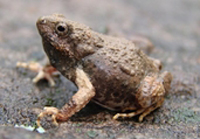It’s not easy being green, as Kermit the Frog famously lamented on the TV show, “Sesame Street,” but it might be getting easier thanks in part to the Tungara frog—a native of Central and South America. David Wendell of the University of Cincinnati recently led a study that developed a new type of foam that can absorb CO2 and convert it to sugar before it escapes into the atmosphere (a process that occurs naturally in plants during photosynthesis). A key ingredient in the foam, which could be placed into the exhaust systems of power plants, is a protein that is naturally created by the Tungara frog to form a foam nest that protects their eggs. (Here’s a brief video showing a frog weaving the nest.) 
“I read about a protein that the frog uses that allows bubbles to form in the nest, but doesn’t destroy the lipid membranes of the eggs that the females lay in the foam, and realized that it was perfect for our own foam,” says Wendell. The CO2-absorbing foam is an amalgam of numerous enzymes harvested from plants, fungi, bacteria, and frogs, and it converts all of the solar energy it captures into sugars, making it as much as five times more efficient than plants, and, according to Wendell, “the first technology that actually consumes more carbon than it generates.” The invention recently won the $50,000 grand prize at the 2010 Earth Awards, which were founded in 2007 to encourage innovative designs “to improve our quality of life and build a new economy.”